

Aeta. Lumad peoples. Moro people. The Moro people, or Bangsamoro, are a population of ethnically indigenous Muslims in the Philippines, forming the largest non-Catholic[1] group in the country, and comprising about 5% of the total Philippine population.[2] There are various Moro ethnic groups, although other smaller tribes are also called "Moro", as the majority of their populations are also Muslims.
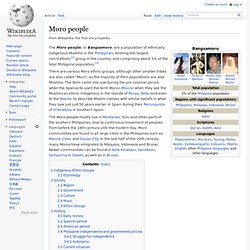
The term came into use during the pre colonial period, when the Spaniards used the term Moros (Moors) when they see the Muslims as ethnic indigenous in the islands of Panay, Cebu and even to the Manila, to describe Muslim natives with similar beliefs in what they saw just just 50 years earlier in Spain during their Reconquista of Al Andalus in Southern Spain. The Moro people mostly live in Mindanao, Sulu and other parts of the southern Philippines.
Indigenous Ethnic Groups[edit] Moros. Hiligaynon people. Hiligaynon style Guinomis (sago in coconut syrup with toasted rice) The Hiligaynon, often referred to as Ilonggo,[1] are a Visayan ethnic group indigenous to the large coastal plain of east Panay island.
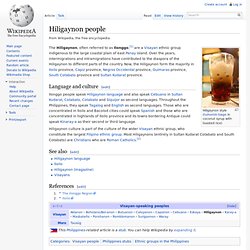
Surigaonon people. The Surigaonon people are part of the wider Visayan ethnolinguistic group, who constitute the largest Filipino ethnolinguistic group.

Although traditionally grouped with the Cebuanos, the Surigaonons are a distinct identity. Area[edit] Surigaonons populate the eastern coastal plain of Mindanao, particularly the provinces of Surigao del Norte, Surigao del Sur and Dinagat Islands. They are also present in the provinces of Agusan del Norte, Agusan del Sur, and in Davao Oriental. Demographics[edit] Currently, the Surigaonons number about 1,000,000 (estimates) based on the population of Surigao del Norte, Surigao del Sur and some speakers of Agusan del Norte.
Their ancestors were the Austronesian-speaking immigrants who came from South China during the Iron Age. Below table demonstrates that Surigaonon is more related to Tausug than Cebuano[edit] Waray people. Bicolano people. Tagalog people. Name[edit] Demographics[edit] Tagalog people number about 28.1% of the Total Filipino population making them the second largest major indigenous Filipino ethnic group, second to Visayans.[3][4][5][6] Tagalogs speak the Tagalog language, with many dialectal variations, although all Tagalog dialects are considered to be mutually comprehensible to each other.

The main religion of Tagalogs is Christianity, mainly Roman Catholicism with a minority practicing Islam, mainly the Quiapo district of Manila. Predominantly Tagalog-speaking regions in the Philippines. Kapampangan people. The Kapampangans are an Austronesian people native to and the sixth largest ethnic group in the Philippines, numbering about 2,890,000.
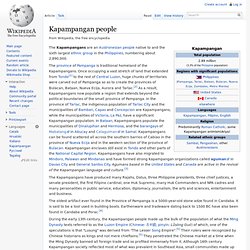
The province of Pampanga is traditional homeland of the Kapampangans. Once occupying a vast stretch of land that extended from Tondo[1] to the rest of Central Luzon, huge chunks of territories were carved out of Pampanga so as to create the provinces of Bulacan, Bataan, Nueva Ecija, Aurora and Tarlac.[2] As a result, Kapampangans now populate a region that extends beyond the political boundaries of the small province of Pampanga. Pangasinan people. Ilocano people. The Ilocano or Ilokano people are the third largest Filipino ethnolinguistic group.
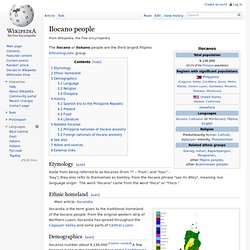
Etymology[edit] Aside from being referred to as Ilocanos (from "i" – 'from', and "looc" – 'bay'), they also refer to themselves as Samtoy, from the Ilocano phrase "sao mi ditoy", meaning 'our language origin'. The word "Ilocano" came from the word "Iloco" or "Yloco.
" Cebuano people. The Cebuano people (Cebuano: Sugbuanon) are a Visayan ethnic group in Cebu and form the second largest cultural-linguistic group in the Philippines.[2] History[edit] Oceanic or Austronesian people called Malayo-Polynesians settled Cebu island and the rest of the Philippines around 30,000 years ago.
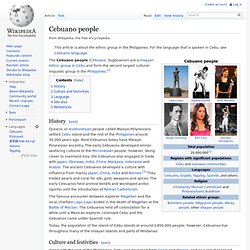
Most Cebuanos today have Malayo-Polynesian ancestry. The early Cebuanos developed similar seafaring cultures to the Micronesian people; however, being closer to mainland Asia, the Cebuanos also engaged in trade with Japan, Okinawa, India, China, Malaysia, Indonesia and Arabia. The ancient Cebuanos developed a culture with influence from mainly Japan, China, India and Borneo.[3] They traded pearls and coral for silk, gold, weapons and spices.